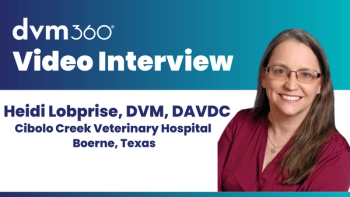
Cornell launches clinical trial of once-weekly GLP-1 therapy for feline weight management
Cornell University is enrolling client-owned cats in an 11-week trial of AKS-562c, a once-weekly GLP-1 Fc-fusion candidate designed to reduce appetite and produce clinically meaningful weight loss while closely monitoring safety and tolerability.
A Cornell University–led clinical trial is enrolling client-owned cats to evaluate AKS-562c, a once-weekly GLP-1 Fc-fusion candidate developed by Akston, for safety and efficacy as an adjunct to nutritional management of excess body condition. Pending trial results, the therapy could become a practical pharmacologic adjunct to multimodal weight-management plans in feline patients.¹
Epidemiology and clinical importance
Surveillance by the Association for Pet Obesity Prevention (APOP) found that 61% of evaluated US cats were classified as overweight or having obesity in 2022, underscoring the prevalence of the problem in clinical populations.2 Owner recognition of unhealthy body condition appears to be improving, but remains imperfect. In APOP’s 2024 Pet Weight & Nutrition Opinion Survey, 33% of US cat owners categorized their cats as overweight or having obesity (up from 28% in 2023), and many owners remain unfamiliar with formal body condition scoring tools.³
These prevalence and perception data may point to an ongoing need for evidence-based interventions that work in the real world, especially those that reduce owner burden for dosing and feeding management.
Clinical consequences of excess adiposity in cats
Excess adiposity in cats is linked to multiple pathologies, most notably insulin resistance and type 2 diabetes mellitus, orthopedic disease, and decreased physiological reserve. Recent veterinary reviews summarize the epidemiologic risk factors and associated pathologies of feline overweight and obesity and emphasize that obese cats are 7 times more likely to develop diabetes and other metabolic disturbances.⁴
"Feline obesity is one of the most common yet least effectively treated health issues in veterinary medicine," Todd Zion, PhD, co-founder and chief executive officer of Akston, said. "By advancing a once-weekly GLP-1 therapy, we're addressing a real unmet need and aiming to give cats the chance at longer, healthier lives."
The Cornell University clinical trial
GLP-1 receptor agonists reduce appetite and slow gastric emptying via central and peripheral pathways that increase satiety and reduce caloric intake. In human medicine, these agents have demonstrated clinically meaningful weight loss with an acceptable safety profile when used within appropriate monitoring frameworks.⁵
Akston (the product developer) and the Cornell University College of Veterinary Medicine in Ithaca, New York, have initiated a clinical study to evaluate AKS-562c, an Fc-fusion GLP-1 candidate, in client-owned cats. The study is intended to assess both efficacy (weight loss) and tolerability in a real-world population of owned animals. The trial’s headline parameters include an ~11-week treatment period, an enrollment target of 70 cats with an option to expand to 140, and leadership by Patrick Carney, DVM, PhD.¹
The primary objectives of the study are:
- Quantify weight change associated with once-weekly AKS-562c administration in client-owned cats.
- Describe the incidence and character of treatment-emergent adverse events.
By enrolling owned animals and assessing owner-reported and clinic-based outcomes, the study design supports direct translational relevance to small-animal practice, according to an Akston press release.¹
In the release, Akston reports preclinical data from laboratory cats at Cornell indicating reductions in voluntary food intake without adverse effects or “unanticipated events.” The company said pharmacokinetic analysis supported once-weekly dosing in those studies. The drug is built on Akston’s proprietary Fc-fusion platform, which the company says can extend duration of action and streamline development of long-acting protein therapeutics.¹
"Feline obesity is one of the most common yet least effectively treated health issues in veterinary medicine," Zion said. "By advancing a once-weekly GLP-1 therapy, we're addressing a real unmet need and aiming to give cats the chance at longer, healthier lives."
Akston is also advancing a related GLP-1 program for dogs using the same Fc-fusion platform, which is approximately 6 months behind the feline program.¹
References
- Akston. Akston Initiates Clinical Trial of Once-Weekly GLP-1 Weight-Management Therapy for Cats. PR Newswire. Nov 25, 2025. Accessed November 25, 2025.
https://www.prnewswire.com/news-releases/akston-initiates-clinical-trial-of-once-weekly-glp-1-weight-management-therapy-for-cats-302625679.html . (PR Newswire ) - Association for Pet Obesity Prevention. 2022 State of US Pet Obesity Report. 2022. Accessed November 25, 2025.
https://static1.squarespace.com/static/6425ec5d33eaaa634113b2d4/t/6454f61c0cad164860799c8f/1683289630779/2022%2BState%2Bof%2BUS%2BPet%2BObesity%2BReport.pdf . - Association for Pet Obesity Prevention. 2024 Pet Weight & Nutrition Opinion Survey (Executive Summary). Accessed November 25, 2025.
https://www.petobesityprevention.org/2024-survey . - Saavedra C, Pérez C, Oyarzún C, Torres-Arévalo Á, et al. Overweight and obesity in domestic cats: epidemiological risk factors and associated pathologies. J Feline Med Surg. 2024;26(11):1098612X241285519. doi:10.1177/1098612X241285519.
- Collins L. Glucagon-like peptide-1 receptor agonists. In: StatPearls. StatPearls Publishing; 2024. Accessed November 25, 2025.
https://www.ncbi.nlm.nih.gov/books/NBK551568/
Newsletter
From exam room tips to practice management insights, get trusted veterinary news delivered straight to your inbox—subscribe to dvm360.






